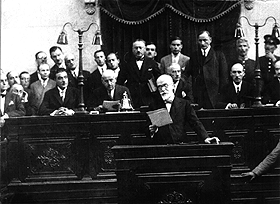

|
The Interwar Period and the Constitution of 1927 The interwar period was marked by the attempts of reorganizing the country after the recent dramatic changes that resulted the
Asia Minor catastroph. The political dichotomy of the population was a continuous result of the "National Schism". At a
parliamentary level, this period was stigmatized by a series of upheavals and governmental changes as well as political conflicts
about the character of the regime. A characteristic example of the institutional malfunction was the establishment of the
democratic regime in 1924 by a government that had abolish the constitutional legitimacy. In 1926, there was an attempt to
reestablish the political legitimacy by announcing new elections and appointing a committee for the elaboration of a new
constitution.
|
 |
|
The constitution of 1927 was the most complete and progressive, even though it was based on the previous constitution of 1911
and the stillborn one of 1925. The new constitution established the position of the President of Democracy and brought back the
Senate that was elected and acted like a high court. According to the new constitution, for a party to become the government,
they had to have the vote of trust of the parliament. The new constitution founded the Council of Sovereign as the highest
administrative court. It improved the security of several individual liberties and it introduced to Greece certain social rights,
such as the freedom of art and science, the right to work, etc.
 Venizelos during a session in Parliament |